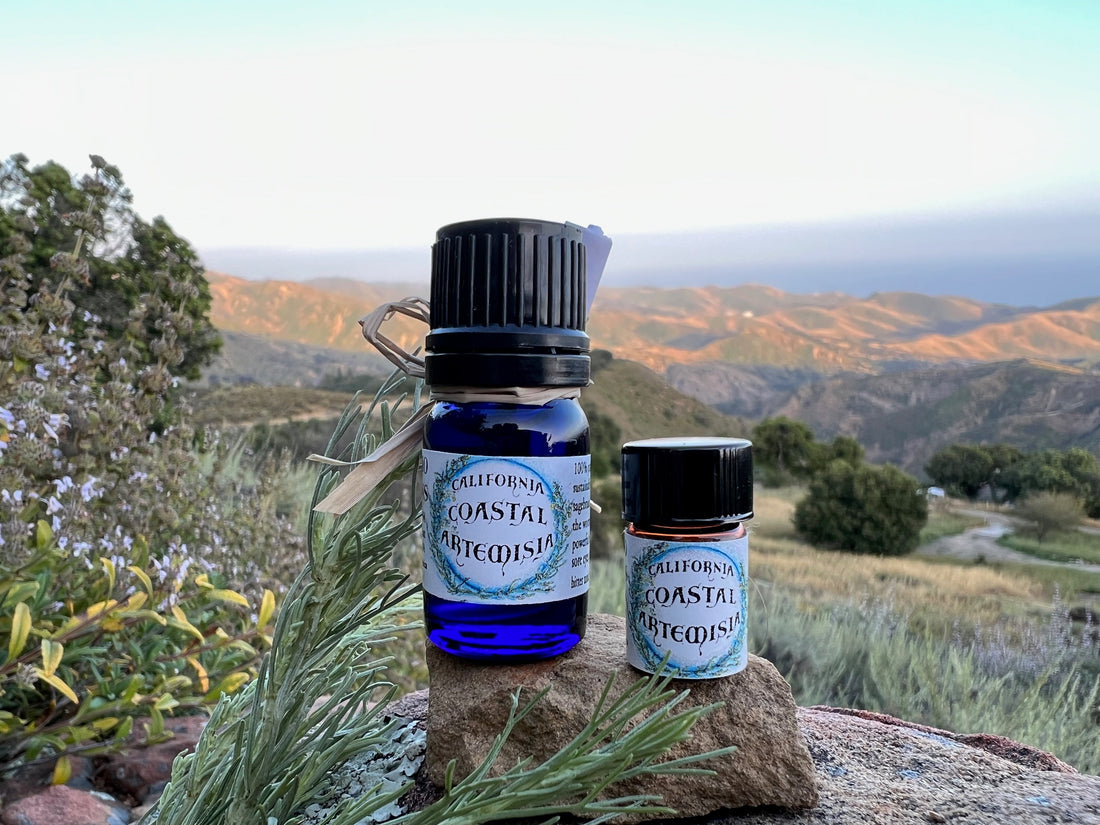
Therapeutics of California Sagebrush: A Medicinal California Native Plant Profile
Share
Artemisia californica — California Sagebrush
Common names: Old Man’s Sagebrush, Cowboy Cologne, Coast Sage
Family: Asteraceae (Sunflower Family)
Pharmaceutical name: Herba Artemisiae Californicae
Experience Sagebrush Firsthand
Explore our California Sagebrush Essential Oil, sustainably wildharvested and artisan-distilled on our Refugio Gardens ranch. Known as “Cowboy Cologne,” this pure oil captures the crisp herbal essence of wild California’s coastal mountains.
Characteristics
- Plant: Very bitter, pungent, slightly sweet, aromatic, cooling
- Essential Oil: Sweet, woody, pungent, camphoraceous; cool top and middle notes
- Hydrosol: Similar to the oil; slightly musty and bitter
Channel Tropism (TCM)
- Stomach
- Lungs
- Liver
- Uterus
Western Actions
Antifungal, antimicrobial, antioxidant, anthelmintic, aperitive, stomachic, cholagogue, antispasmodic, antirheumatic, diaphoretic, vermifuge, emmenagogue
Traditional Chinese Medicine: Actions & Indications
- Invigorates Blood & Regulates Menses: Dysmenorrhea, cramps, amenorrhea
- Kills Parasites: Pinworms, roundworms
- Clears External Wind-Heat: Fever without sweat, nausea, poor appetite, bitter taste
- Diffuses Lung Qi: Cough, wheezing, bronchial conditions
- Cools the Stomach & Disperses Liver Qi: Indigestion, acidity, bitter taste
- Heals Wounds & Regenerates Tissue: Topical on wounds and sores
- Reduces Blood Stagnation & Pain: Poultice for toothache, bruises, swelling
Cautions & Contraindications
- Contraindicated during pregnancy
- Internal use cautioned; Artemisia spp. may contain thujone (neurotoxic at high doses)
Clinical Information
- Inhalation commonly lifts mood and clarity
- Diluted hydrosol reported to ease abdominal discomfort
- Topical use supports relief of body aches
- Children sipping diluted hydrosol described warmth and improved mood
- Hydrosol character often compared to a peppermint-like herbal tea
Essential Oil & Hydrosol Treatment Protocol
Topical Use
- Always patch test first
- If irritation occurs, dilute 15 drops essential oil in 1 oz (30 mL) carrier oil and retest
Internal (Traditional Hydrosol Use)
Diluted hydrosol traditionally used for stomachache, fever, menstrual discomfort, parasites, and lung conditions (practitioner guidance recommended).
Inhalation
Diffuse essential oil for asthma, bronchial conditions, colds, and fever support.
Bath or Poultice
Add essential oil (dispersed in carrier) or hydrosol to bathwater, or apply as a poultice for cramps, soreness, or swelling.
Personality
California Sagebrush is clean and refreshing: crisp, sweet, cedar-like with sage and camphor hints — opening the lungs, clearing the meridians, and sweeping away mental fog.
Discovery & Innovation
In 1999, Dr. Amy Inez Hazard became the first known artisan distiller to capture the essential oil of Artemisia californica. At the time, its essential oil had not been formally distilled or characterized.
While walking the Refugio Gardens ranch with her mentor and thesis supervisor, internationally respected aromatherapist Peter Holmes, he touched the plant’s resinous leaves and said: “Try a distillation, Amy. It may have an excellent essential oil.” Encouraged by his insight, she performed the first steam distillation, revealing the crisp, camphoraceous fragrance later nicknamed “Cowboy Cologne.”
Today, Refugio Gardens continues to distill small-batch, GC–MS verified Sagebrush oil, remaining the original artisan source of this rare California native aromatic.
Modern Research on Pain Relief
Scientific and practice observations support traditional topical use: sagebrush liniments demonstrate notable anti-inflammatory and analgesic effects attributed to complex terpenoids and flavonoids. Users commonly report comfort for sore muscles and joints and faster recovery following strain. †
Ethnobotany
- Native Americans: Menstrual cramps, coughs, asthma, rheumatism, parasites, wounds; purification rituals, sweathouse ceremonies, postpartum recovery
- Spanish settlers: Tea for bronchial conditions; washes for wounds, sore muscles, bruises
- Miners: Sprigs in bedding to repel fleas
- Related species: Artemisia absinthium (wormwood) in Europe for parasites, digestion, liver/gallbladder support
Ecological Role
Artemisia californica helps maintain open coastal sage scrub via allelopathy (resinous oils suppress competitors), supporting wildlife like the California gnatcatcher.
Wild-Grown Potency
Plants from hotter, drier southern locales concentrate key monoterpenes, intensifying aroma and complexity — supporting the observation that wild-grown, coastal-mountain populations express distinctive potency tied to terroir.
Experience Wild California
Bring the heritage and aroma of Artemisia californica into your rituals. Our California Sagebrush Essential Oil — “Cowboy Cologne” — is sustainably wildharvested, pure, and artisan-distilled in small batches at Refugio Gardens.
Major Known Essential Oil Constituents
- 1,8-Cineole (23.99%)
- Artemisia ketone (18.05%)
- Camphor (8.71%)
- Piperitone (7.60%)
- α-Thujone (4.80%)
- α-Pinene (2.56%)
- Camphene (2.15%)
- Artemisia alcohol (2.04%)
- Santolinatriene (1.71%)
- Yomogi alcohol (1.66%)
- Terpinen-4-ol (1.46%)
- β-Thujone (1.33%)
- Plus many trace constituents (<1%)
California Sagebrush FAQ
What is California Sagebrush essential oil?
An artisan-distilled oil from Artemisia californica, known as “Cowboy Cologne,” with clarifying, purifying, and mood-lifting qualities.
How is your Sagebrush oil sourced?
Responsibly wildharvested on private ranch land in Santa Barbara and distilled in small batches at Refugio Gardens.
Is there research on topical relief?
Yes. Sagebrush liniment shows anti-inflammatory and analgesic activity consistent with traditional uses for muscle and joint comfort.
How do I use it?
Diffuse for respiratory clarity; dilute for topical massage; hydrosol may be used traditionally with practitioner guidance.
Disclaimer
This article is provided for educational purposes only. California Sagebrush has a long history of traditional use, but these statements have not been evaluated by the FDA. This content is not intended to diagnose, treat, cure, or prevent any disease. Always consult a qualified practitioner before using herbal products.
† For references and study details, see our References page.
